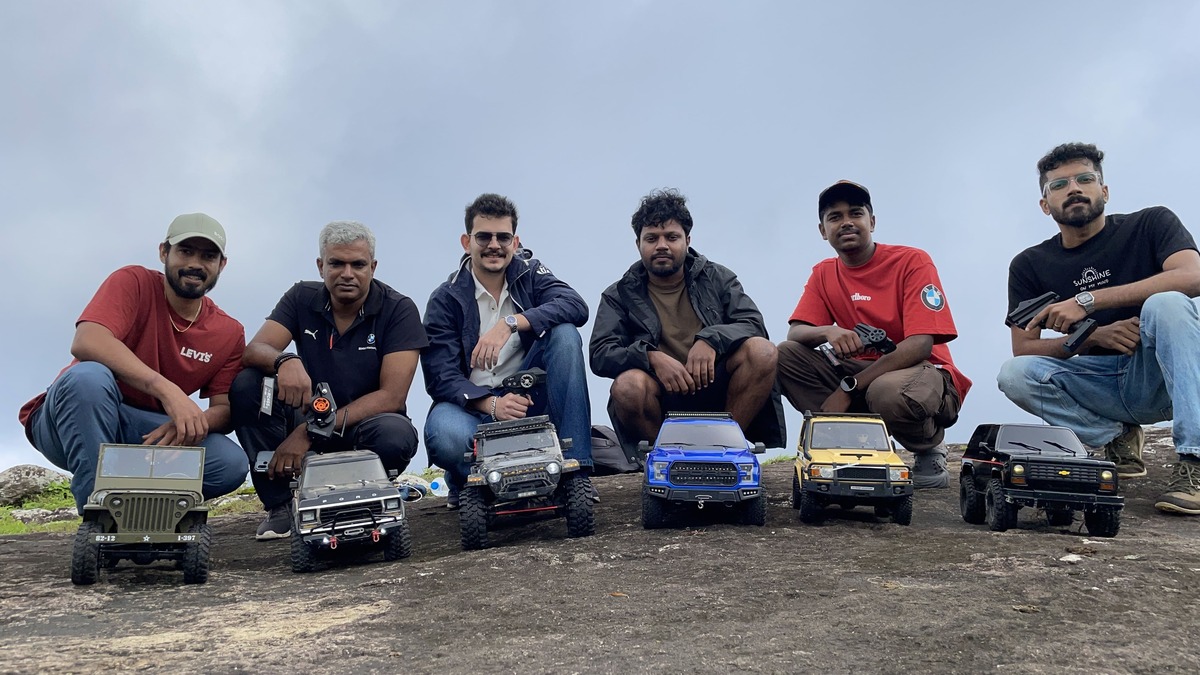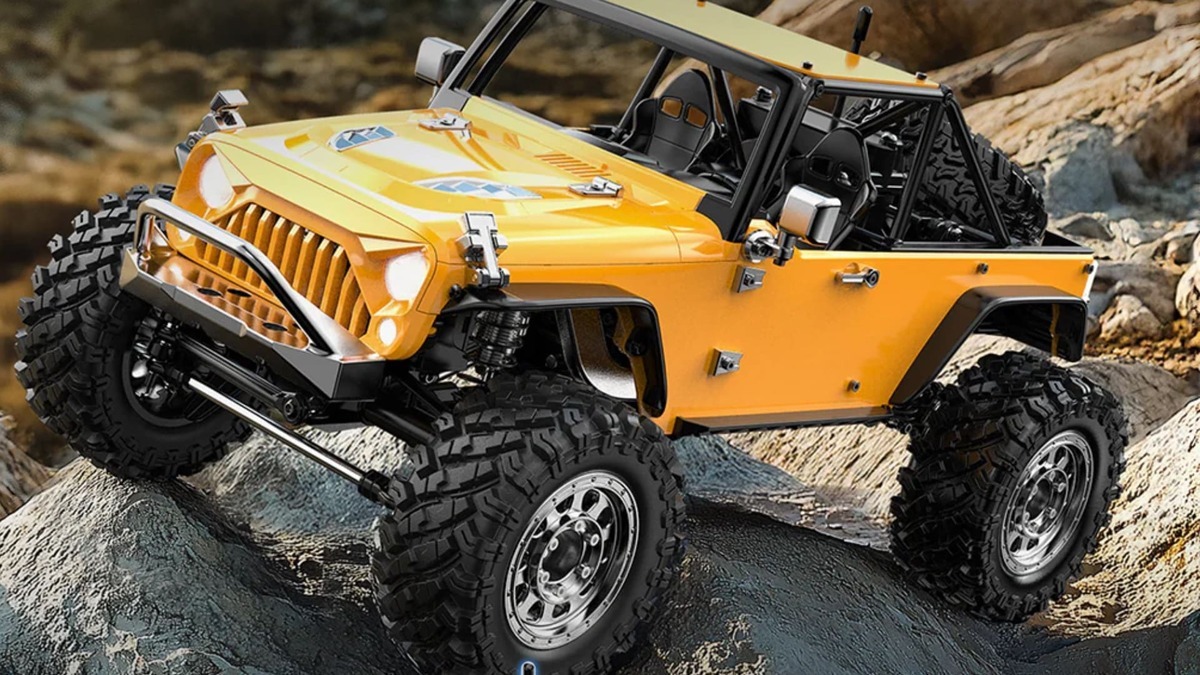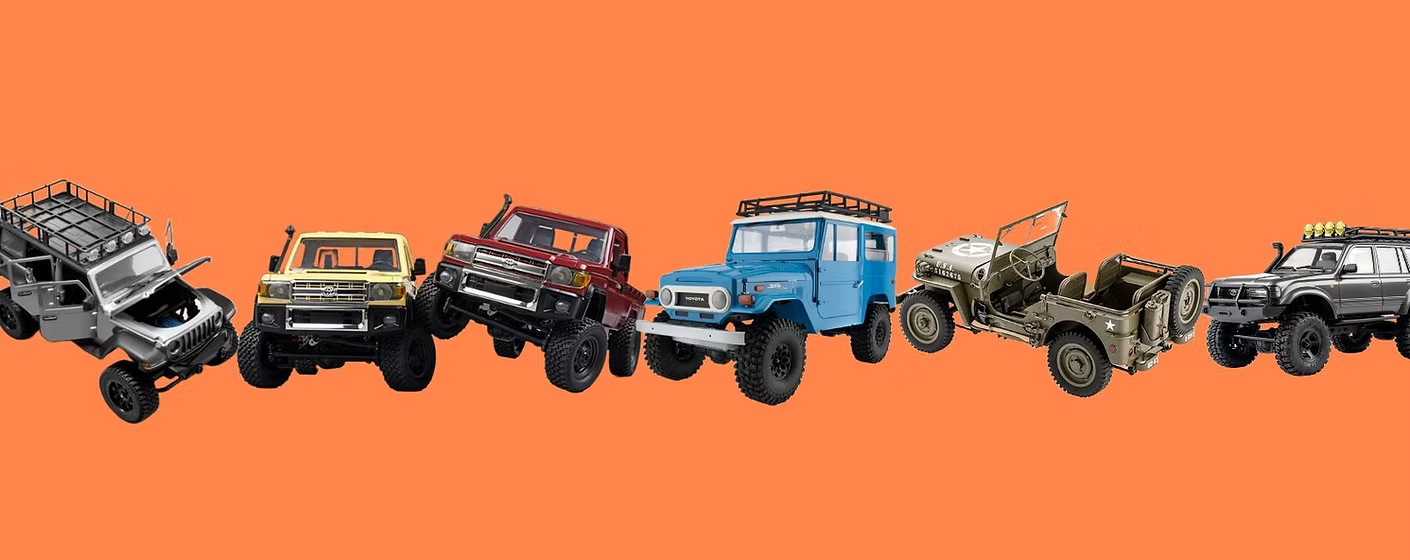Kerala, with its lush landscapes, monsoon-kissed trails, and rugged hill paths, offers a thrilling playground for RC off-roading. Whether you’re tackling muddy paddy fields, rocky highlands, or forested footpaths, the right gear and know-how can make or break your experience. In this detailed guide, we’ll walk through everything you need—from selecting your RC car to tuning it for local terrain, choosing the right tyres, powering it smartly, and keeping it running in top form.
🚙 Choosing the Right RC Car
The first step in a rewarding off-road journey is choosing a vehicle that can handle the landscape. In Kerala’s diverse terrain, 1:10 or 1:12 scale RC crawlers offer the best balance between size and capability. These rigs are large enough to handle outdoor trails, yet portable enough to take anywhere.
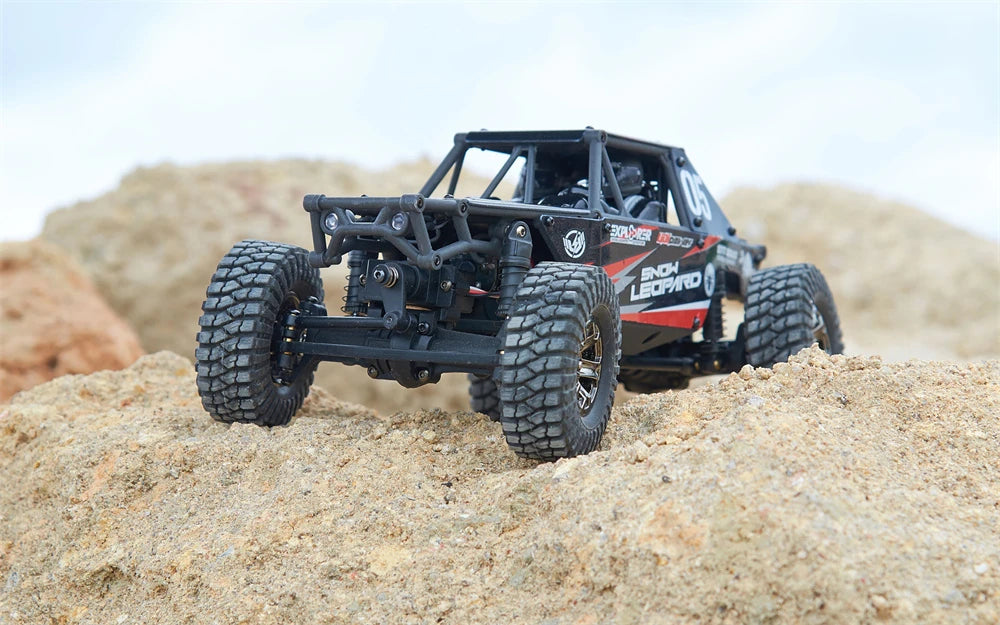
Preferably, go for crawler-style vehicles. Their high torque, lower speeds, and detailed suspension systems make them ideal for navigating rock beds, hilly regions, and damp undergrowth. Ensure your chosen model comes with 4WD, metal gears, and oil-filled shocks—these components ensure durability and traction in wet or loose terrain. Brands like FMS, Axial, and Traxxas are known for their reliable performance in such conditions.
🛞 Picking the Right Tyres for Kerala Terrain
Tyres are everything when it comes to off-roading, especially in Kerala’s slippery and variable environments. If you’re hitting forest trails or monsoon-wet tracks, knobby tread tyres with a soft compound provide the best grip. In sand or dried-up paddy fields, wide, blocky patterns help prevent sinking or wheel spin.
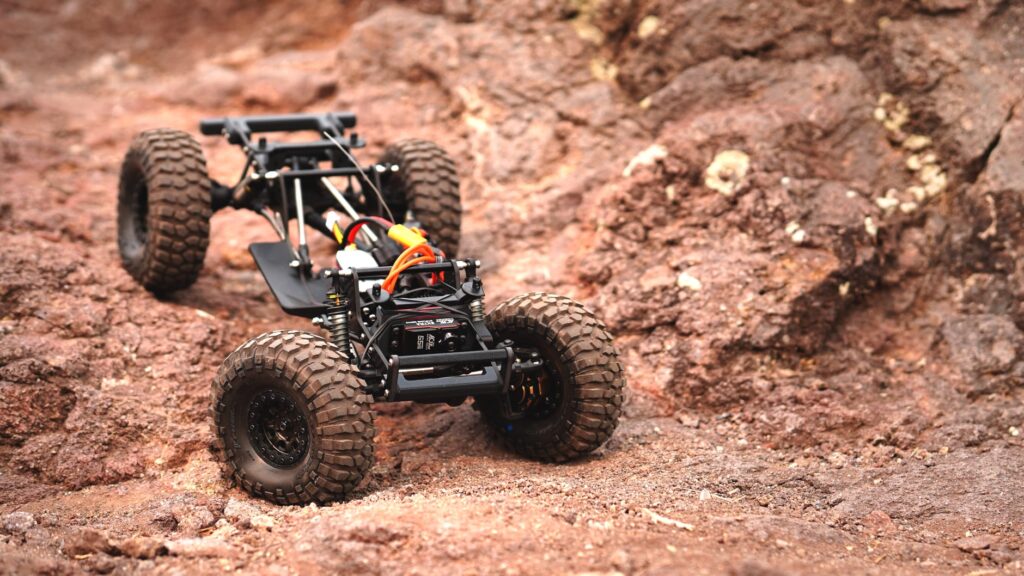
Always use foam inserts—they help retain tyre shape and distribute weight evenly. Closed-cell foam is particularly effective for wet or rocky terrain. For scale, 1.9” tyres are a safe bet for most 1:10–1:12 RCs. After every run, wash the tyres to remove mud and grit, and inspect for any signs of cracking or wear.
🔋 Battery & Power Tips
For Kerala’s often long and humid trail sessions, LiPo batteries (2S or 3S) are recommended. They’re lightweight, pack power efficiently, and last longer than NiMH alternatives. Aim for 5,000–6,000 mAh to get 30–40 minutes of crawling time, depending on your car and terrain. Many rigs even allow mounting two batteries—a huge advantage if you’re deep into the backwoods.
Charging safely is just as important. Use a balanced LiPo charger, and avoid over-discharging. Always store batteries in a fire-safe bag and never charge them unattended—Kerala’s heat and humidity can exaggerate battery issues.
⚙️ Suspension Setup & Chassis Tuning
Kerala’s trails throw everything at your vehicle—rocks, muddy ruts, wet roots, and uneven grass beds. To absorb that impact smoothly, your car should have oil-filled shocks tuned with mid-weight oil (30–45 wt). Go for softer springs in muddy areas to help with rebound and grip.
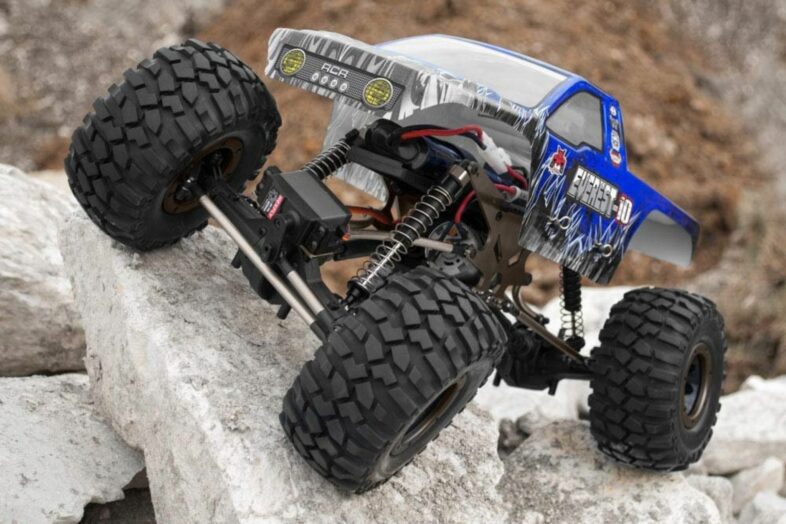
Set your ride height higher—at least 35–40mm ground clearance helps avoid belly strikes on rough terrain. Protect your chassis with skid plates, metal links, and rock sliders, especially if you’re riding through gravel riverbeds or forested slopes. These add longevity and help avoid breakage.
💧 Waterproofing Electronics
Monsoon is always around the corner in Kerala. That’s why it’s essential to protect your vehicle’s brain—the ESC, motor, and receiver. Many models come with water-resistant electronics, but if yours doesn’t, use conformal coating or waterproof enclosures. A small bead of silicone around ports and connectors adds an extra layer of safety.
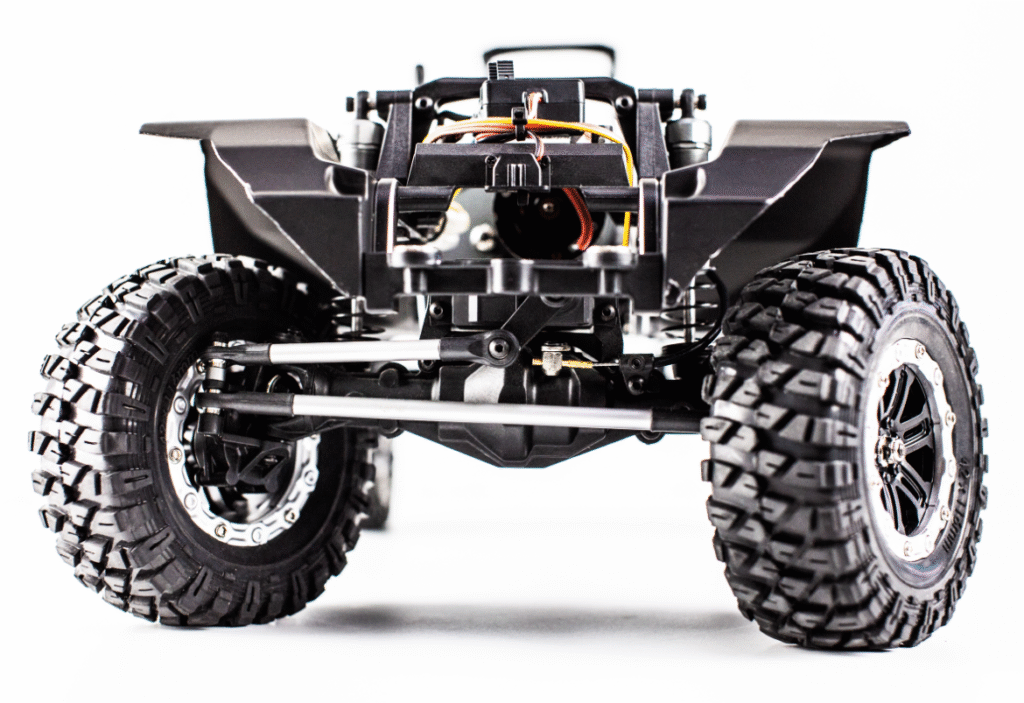
Waterproof servos and sealed bearings will significantly reduce the chances of rust and mechanical failure. Even with all precautions, avoid full submersion unless your car is explicitly designed for it.
🧭 Driving Techniques for Local Terrain
Driving skill makes a huge difference. In wet or mossy areas, always ease into throttle—punching it will only cause loss of grip. Use gentle throttle modulation to crawl, and keep a finger ready on reverse to adjust instantly.
When climbing, approach obstacles head-on. Lateral climbs often tip the vehicle. On downhill descents, let gravity help—use brakes gently and steer with flow, not against it. If you’re in a paddy field or slippery clay soil, avoid sharp turns; wide arcs maintain momentum without digging in.
🌾 Adapting to Terrain Types
Kerala’s landscape is ever-changing. You might be in Wayanad’s hills today and on a Kozhikode beach tomorrow.
- Rocky trails: Use grippy tyres and lock the differentials if available. Protect your undercarriage.
- Forest/mud: Soft suspension helps maintain contact. Clean after every ride.
- Beaches: Run wider tyres and rinse your RC with fresh water immediately after exposure to salt.
- Tea estate slopes: Keep your center of gravity low—avoid top-heavy body kits or cameras.
🛠️ Maintenance & Longevity
Regular maintenance ensures your vehicle lasts. After each session, remove debris and wipe down with a soft cloth. Check for loose screws, and re-lube moving parts with silicone grease or bearing oil. Remove wheels occasionally to clean hub assemblies.
Store your RC car in a dry, dust-free place. In Kerala’s humid conditions, moisture is a slow killer—dry your electronics thoroughly after every wet session. If you use LiPo batteries, store them at 50% charge when not in use for extended periods.
🎥 Filming Your Runs
If you’re planning to document your RC adventures, mount a lightweight action cam on your RC’s hood or roof rack. A gimbal mount helps reduce vibration, especially on rocky trails. You can also try FPV setups for a first-person drive perspective.
Editing short clips with music or trail sound effects adds a dramatic touch. Share on YouTube or Instagram with tags like #KeralaRC, #RCMechTrails, and #MiniCrawlersKerala to reach fellow hobbyists.
📍 Connect with Kerala’s RC Community
There’s a thriving but niche RC scene in Kerala. You’ll find WhatsApp groups and Facebook communities connecting enthusiasts in Kochi, Trivandrum, and Kozhikode. Occasional trail runs and informal meets happen at places like Fort Kochi beach, Vagamon hills, and Athirapally trail routes.
Joining these groups not only helps you find local trails but also gives you access to spares, advice, and shared knowledge.
✅ Final Thoughts
RC off-roading in Kerala is more than a hobby—it’s an adventure. With the right vehicle, carefully chosen tyres, smart battery use, and terrain-appropriate techniques, you can experience the joy of exploring Kerala’s landscapes on a miniature scale. Keep your rig maintained, stay safe on trails, and never stop learning from each run.
Whether you’re crawling up a tea estate path or navigating a monsoon-drenched forest track, the fun is in the challenge—and in how well-prepared your RC car is to face it.

